BRANDING | PACKAGING DESIGN
EXPERIMENT | ART EDUCATION
Food as the Analog(y),
EXPERIMENT | ART EDUCATION
Food as the Analog(y),
Design as the Outcome
01.2023 — 05.2023
Food as the Analog(y), Design as the Outcome explores the art of craft in design by using the methodology of making and serving food. This project is a celebration of craft, experimentation, and collaboration. This thesis challenges the traditional assumptions of what design is, who has access to design, and where design can exist. As the title suggests, this thesis is understood in two parts: Food as the Analog(y) and Design as the Outcome. The first part examines how food can be understood as a methodology for design. The second part explores how design takes form through the process of making and collaborating, which ultimately creates conversation. This body of work is a conversation at the dinner table, full of bold statements: Food is craft. Food is language. Food is process. Food is collaboration.
Food as the Analog(y), Design as the Outcome explores the art of craft in design by using the methodology of making and serving food. This project is a celebration of craft, experimentation, and collaboration. This thesis challenges the traditional assumptions of what design is, who has access to design, and where design can exist. As the title suggests, this thesis is understood in two parts: Food as the Analog(y) and Design as the Outcome. The first part examines how food can be understood as a methodology for design. The second part explores how design takes form through the process of making and collaborating, which ultimately creates conversation. This body of work is a conversation at the dinner table, full of bold statements: Food is craft. Food is language. Food is process. Food is collaboration.

Thesis Statement
In middle school, my Friday nights would be spent sitting behind the front desk taking ordersfor customers. My break time would be split between finishing up on my algebra homeworkor peeling peapods with the waiters. I can still feel the oil burning my fingers while I pack thetakeout orders. For some Asian American kids, or “restaurant kids*”, this is a familiar story ofsacrifice and hard work. While working in service, I’ve learned how to work with precision,navigate through customer-worker relationships, and developed a love for cooking. Today, Istill reference these skills in my design practice.
In the same way cooking is to chefs, crafts is to designers, as factors of process and outcomeinspire me to work with analog mediums. Food as the Analog(y), Design as the Outcome is aproject that explores what it means to be of service to people. Through a collection of zines,posters, and interactive materials, this project is a celebration of materials and a test ofrelying on your own hands to create something for someone else.
I hope to create a space for people to reflect on the skills they have learned, while telling avulnerable story of human interaction through service. In the same manner as graphic design,working in service requires an understanding of space, navigation, rhythm, and precision — askilled dance only taught through practice and without choreography. To be bold enough tomake mistakes, yet courageous enough to accept criticism, being a restaurant kid has taughtme how to cook with my heart, craft with
precision, and design with empathy.
* Restaurant Kid: a coined term that describes children, usually Asian American, who’ve worked at arestaurant at a young age.





Publication


